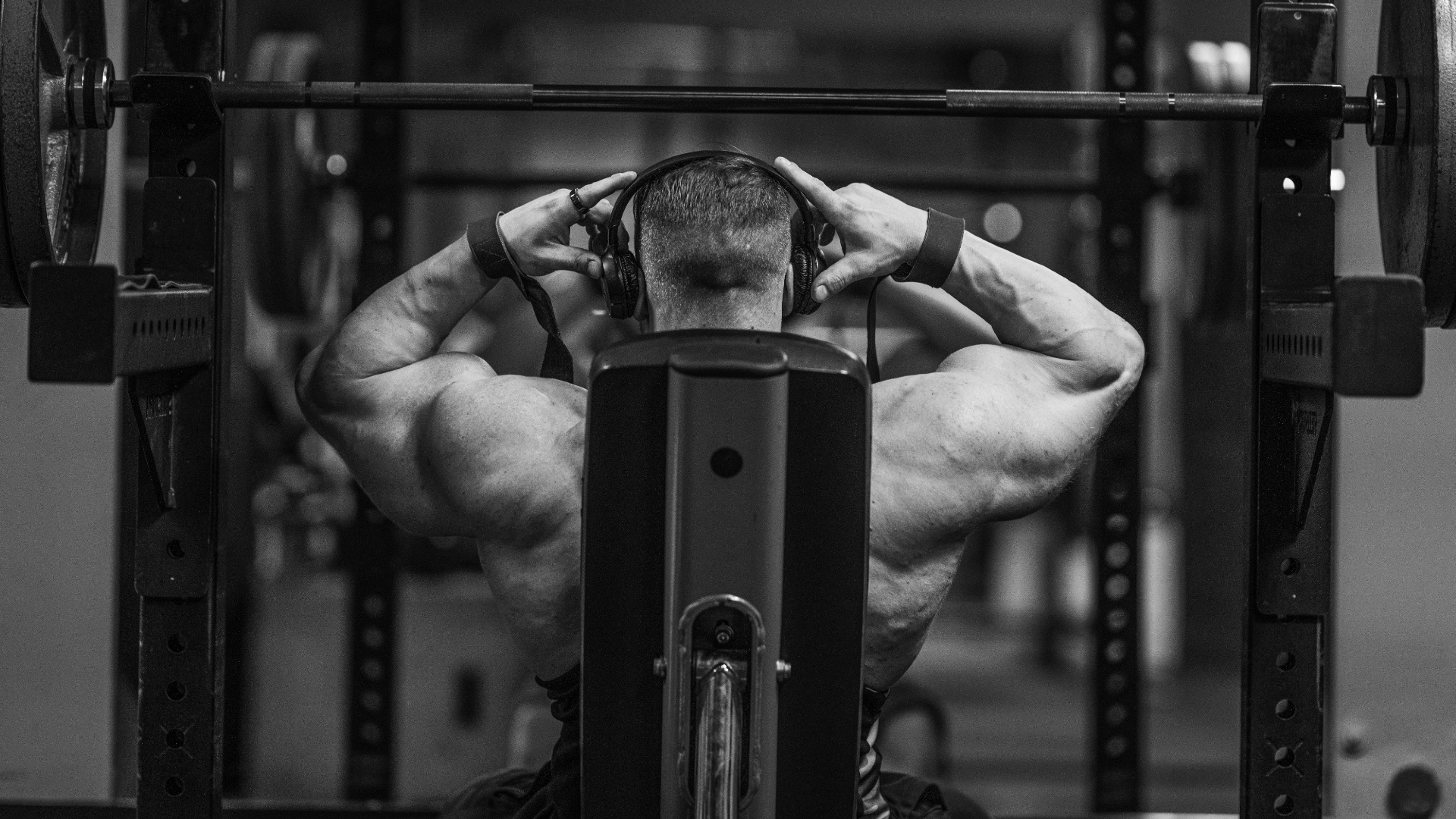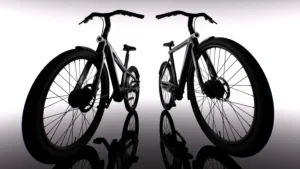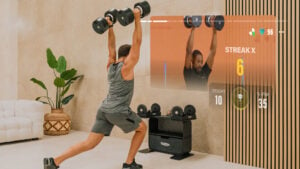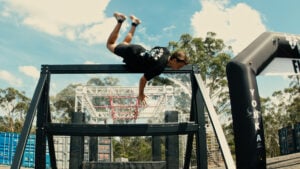If what you want is a big back, hitting the right lat exercises is exactly what you need to be doing. However, making sure you’re properly targeting the lats in isolation can be tricky.
This is why knowing the correct movements is essential to growing the strength and size of your back. There’s no point in smashing back workouts and lifting heavy weights if you aren’t isolating the muscles that you want, so it’s worth taking the time to learn exactly what the lats are, what their function is within your anatomy is, and how to target them for strength and growth.
Below, we’ll discuss the best lat exercises for mass, as well as the number of reps and sets to perform them to the greatest effect.
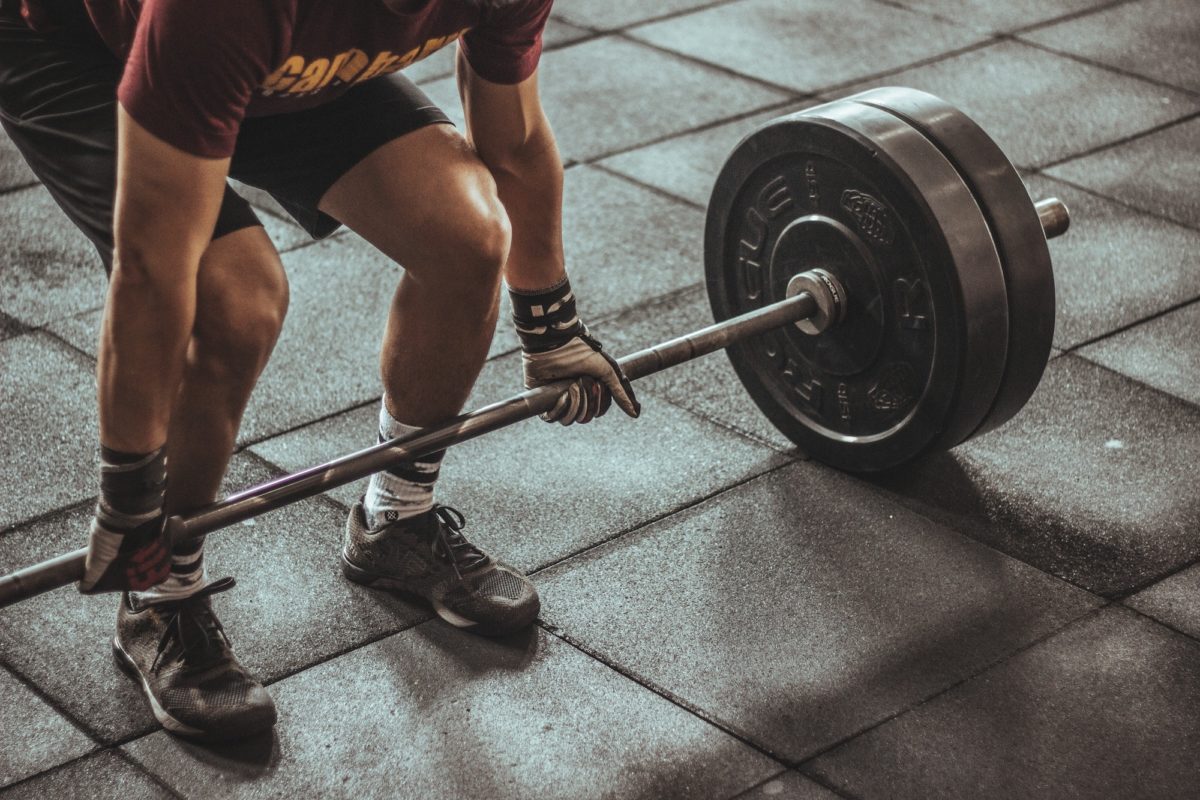
Jump To:
What Are The Different Lat Muscles?
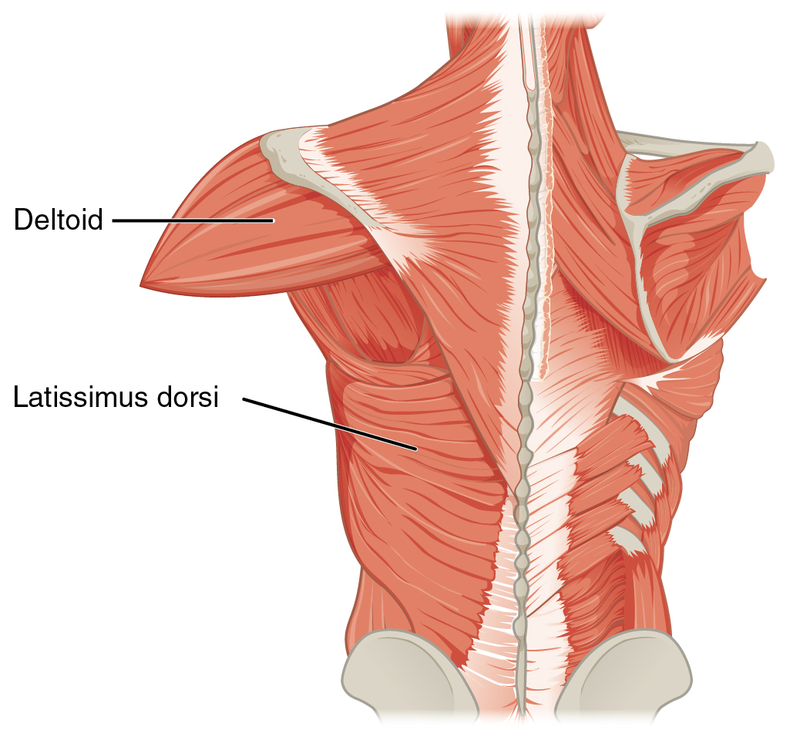
To get the best lat workout, it helps to understand what they are and their purpose in your body. They’re large v-shaped muscles on your back that connect your arms to your vertical column. They serve to stabilize your spine and promote good posture (7).
Lats connect to the upper part of your upper arm bone from the inside. Their main purpose is to allow you to pull and adduct things. Simply put, you will engage your lats anytime you perform a form of rowing motion. You also engage your lats during forceful respiratory functions (8) like coughing.
However, with the wrong grip while performing a rowing action, you may engage other muscles. For example, if your grip is too wide you’ll target your middle traps and the rear deltoid.
Studies (9) suggest that there may be mild advantages of pulling with a medium grip width in the vertical plane. They found that in the upward and downward movements, there were some advantages to using a medium grip rather than a narrow or wide grip.
Why It’s Important To Train Your Lats
Beyond increasing the width of your back, training your lats has tremendous benefits to your overall strength and health. Strong lats can improve your posture and spinal alignment, reducing your risk of back injuries, as well as supporting your core muscles.
The best part of having strong lats is you’ll notice an improvement in your compound lifts, including deadlifts and overhead presses, which in turn will help to increase the overall strength of both your arms and legs. Having big lats is great, but having strong lats is even better.
How To Get Wider Lats
The best way to promote growth in your lats is to activate the muscles in their largest range of motion. This means feeling a stretch through your flank as you’re performing movements such as lat pulldowns, pull-ups, and T-bar rows.
To isolate the lats correctly, it can be worth reducing the amount of weight that you’re lifting and focuing on the feeling of the lat moving through its entire range of motion. Once you’re confident in performing the exercise correctly, you can start to add weight.
The 9 Best Lat Exercises For Strength & Endurance
1. Bent-Over Row
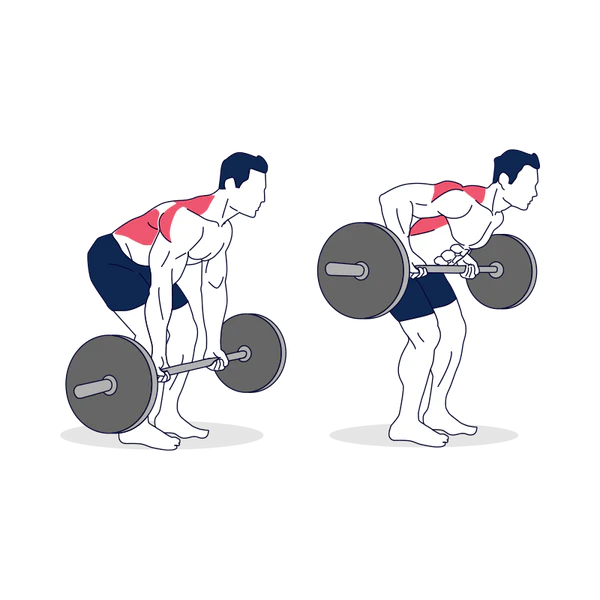
- Difficulty: Intermediate
- Target muscles: Latissimus dorsi, Trapezius, rear Deltoid
- Equipment needed: Barbell
- Sets: 2-4
- Reps: 8-12
- Rest: 60 seconds
Bent-over rows are an exercise that improves back muscle strength (1). It may feel challenging at first, but that’s because it’s a highly effective exercise to build a strong back and pack on mass.
This move isolates your lat muscles, making it an excellent method to strengthen your lats and build them more quickly. To get the best workout, ensure that you hold the proper stance to target the lat and avoid putting pressure on your lower back.
How to do bent-over rows:
- Start with a barbell or a set of dumbbells.
- Stand with your feet shoulder-width apart, keep your knees slightly bent, and lean forward while hanging from your hip.
- Keep your neck in a neutral position with your back straight as you grab the weights. Hold your hands slightly wider than shoulder-width apart.
- Bend your elbows and lift the weight toward your chest. Keep your core engaged as you perform this move.
- Once you get the weight to your chest, pause at the top, squeezing your shoulder blades before slowly extending your arms to lower the weight.
- Pause at the top for a second, then bring the weight back down until your arms are extended.
- Repeat steps 1-6 for the number of reps that match your goals.
You may also try a single-arm dumbbell row to get an incredible upper-arm workout. Start by resting one knee and hand on the same side of the bench. Then, perform the steps with your other arm.
Remember, slow and controlled movements are key to safe lats exercises that properly target your muscles. Beginners should start with three sets of 10 reps using a lighter weight, focusing on proper form.
2. Deadlift
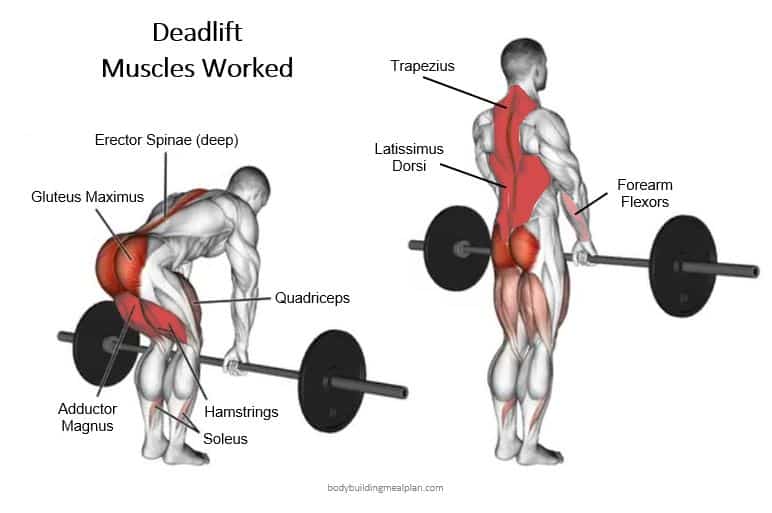
- Difficulty: Intermediate
- Target muscles: Latissimus dorsi, Trapezius, Glutes, Hamstrings
- Equipment needed: Barbell
- Sets: 4-6
- Reps: 6-8
- Rest: 60 seconds
You may have previously done deadlifts to work other areas of your body and wondered how effective they are for your lats. The latissimus dorsi muscles do work their part in the deadlift. Additionally, this exercise allows you to use heavier weights than most workouts, which is ideal for gaining muscle mass and strength (2).
To put your lats to more use during a deadlift, picture oranges in your armpits and imagine crushing them during your exercise. This trick will help you keep your lats engaged, put your upper body into the proper position, and help lift more weight.
How to do a deadlift:
- Use a barbell or two dumbbells. Stand with your mid-foot underneath the weight. Keep your heels slightly narrow, about hip-width apart, and point your toes out 15 degrees.
- Grab the bar or your weights and hinge your hip so you bend over without bending your legs. Keep your grip about shoulder-width apart and your arms straight.
- Slightly bend your knees to drop into position and continue bending them until the bar or inner part of the dumbbell touches your shins. (If the bar shifts position to where it’s not over your mid-foot, start over.)
- Keep your back tall, with an engaged core, and chest out during the movement. Take a deep breath and hold it while you lift the weight back to the top. Keep the weights as close to your shins as you pull.
When performing deadlifts, it’s vital to ensure you maintain the correct posture. Otherwise, you won’t target the lats and could risk injury. If you struggle to engage your core, don’t skip your ab workout.
3. Lat Pulldown

- Difficulty: Beginner
- Target muscles: Latissimus dorsi
- Equipment needed: Cable Machine
- Sets: 2-4
- Reps: 10-15
- Rest: 60 seconds
Lat pulldowns work the latissimus dorsi (3) along with your traps, biceps, rear delts, and rhomboids. This move allows you to train multiple muscles simultaneously, developing strength throughout your upper body and back.
This exercise is low-impact but can help to widen your torso. You’ll need to use a lat pulldown machine to do this exercise and if you’re working out in your home gym, purchasing a set of different handles can be great to mix things up and make sure you’re hitting the entire muscle group.
How to do a lat pulldown:
- Adjust the machine so you can sit comfortably with your back straight, core tight, and feet firmly on the ground.
- To get into the starting position for the classic lat pulldown, reach for and hold the bar with your palms facing away from you.
- Pull the bar toward you, keeping your hands level with your shoulders.
- Keep pulling the bar until it passes underneath your chin. Keep your back and core muscles engaged throughout this movement.
- Hold the bar for a second while squeezing your lats.
- Slowly move the bar back up.
To build mass once you have experience, do 2-4 sets of heavy weights until near failure.
4. Pull Up

- Difficulty: Intermediate
- Target muscles: Latissimus dorsi, Biceps
- Equipment needed: Pull-up bar
- Sets: 2-4
- Reps: Till near failure
- Rest: 60 seconds
Pull-ups strengthen your core, shoulders, back, and of course, your lats. Because your lats are muscles that allow you to pull or row, pull-ups are excellent workouts to strengthen your latissimus dorsi.
Not only are pull-ups a good workout for your upper arms and back, but research (4) shows that pull-ups especially target the lats. Additionally, you’ll strengthen your chest to a lesser extent.
How to do a pull-up:
- Stand below a pull-up bar and place your hands on the bar with your palms facing away from your body and shoulder-width apart. If you struggle to reach the bar, you can stand on a box or bench to help you reach it.
- Now that you’re in the starting position, take in a deep breath and let it out. Lift your feet and body upwards from the floor, so you’re hanging from the bar.
- Engage your core, arms, and back muscles. Bend your elbows to raise your body up towards the bar. Aim to lift your chin over the bar.
- Inhale at the top, then extend your elbows to lower your body back to the starting position.
- You can also perform wide-grip pull-ups to target your lats even more. To do wide grip pull-ups, keep your hands slightly wider than a shoulder-width grip.
- It may be challenging to perform this move on your first try. If you struggle to reach the top, perform progressions to begin increasing your strength until you’re able to. When lifting your body, ensure you’re not shrugging your shoulders or shifting your legs. Keep your shoulder blades back and down throughout the entire exercise.
Perform 2-4 sets of nearly as many reps as you’re able to perform. So, if you can do seven reps, do 5 or 6 for each set.
5. Chin Up
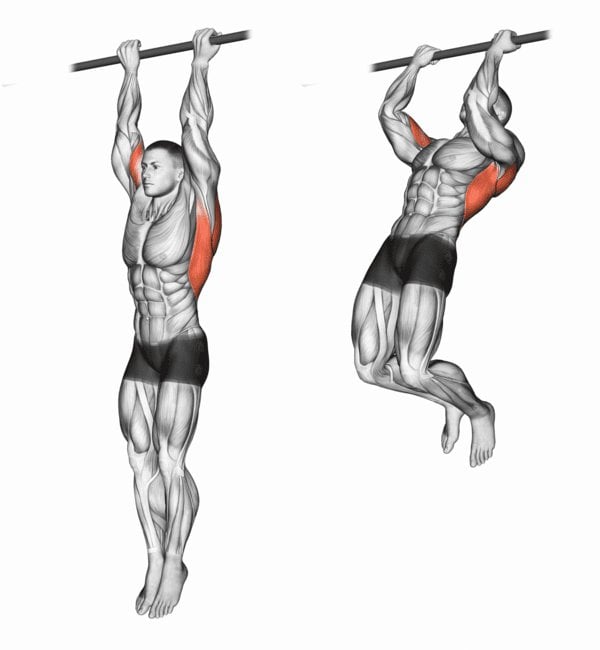
- Difficulty: Intermediate
- Target muscles: Latissimus dorsi, Biceps
- Equipment needed: Pull-up bar
- Sets: 2-3
- Reps: Till near failure
- Rest: 60 seconds
Chin-ups allow you to increase your strength and the definition of your upper arms. Specifically, you’ll grow your lats, biceps, and the posterior deltoids of the shoulder. This move is an excellent way to improve your back muscles and gain strength.
Because of the required grip for chin-ups, this move offers less mobility and less demand on your shoulders. So, chin-ups tend to be more shoulder-friendly than pull-ups.
How to do a chin-up:
- Stand directly beneath the pull-up bar and grab the bar with your palms facing you in an underhand grip. Keep your arms shoulder-width apart.
- Your core and upper body should stay engaged while you perform the movements. To do this, pinch your shoulder blades back and down. Try to keep your hips under you.
- Holding onto the bar, bend your elbows and begin lifting your chest toward the bar. Continue pulling upward until your chin is over the bar.
- Slowly lower your body back to the starting position.
Like the pull-up exercise, chin-ups can be challenging for beginners. To modify this move, begin by hanging on the bar and gradually work towards the ability to hang for one minute.
Start with ten sets of two reps with a minute of rest in between your sets. Shorten your rest periods by 10-15 seconds each week. Once you begin to gain strength, do 1 set of as many reps as possible.
6. Standing Cable Row

- Difficulty: Beginner
- Target muscles: Latissimus dorsi, Trapezius, rear Deltoid
- Equipment needed: Cable Machine
- Sets: 2-3
- Reps: 6-10
- Rest: 60 seconds
Standing cable rows increase upper body strength and target several muscle groups in your back. This move targets your erector spinae (5), rhomboids, and your lower lats. However, your entire latissimus dorsi muscle will get an excellent workout too. You’ll need to use a cable machine to do this exercise and if you’re working out in your home gym, purchasing a set of different handles can be great to mix things up and make sure you’re hitting the entire muscle group.
How to do a standing cable row:
- Adjust the cable row machine to your body so that your back is straight and your feet are flat on the floor.
- Slightly bend your knees and reach for the handles. Ensure your back is still tall and straight.
- Your lower back should be extended, and your shoulders should be directly over your hips.
- Keeping your lats engaged, bend your elbows and move your hands toward your chest.
- Hold for a second, then extend the arms again, ensuring you don’t round your back.
- Return to the starting position.
If it’s your first time performing a cable row, start by using a weight that you can control for 2-3 sets of 6-10 reps. Make sure you’re able to maintain proper posture and a solid technique throughout the entirety of your sets. If you want to work your shoulders, a wide grip seated row is one of the best shoulder exercises that will also work your lats.
7. T-Bar Row
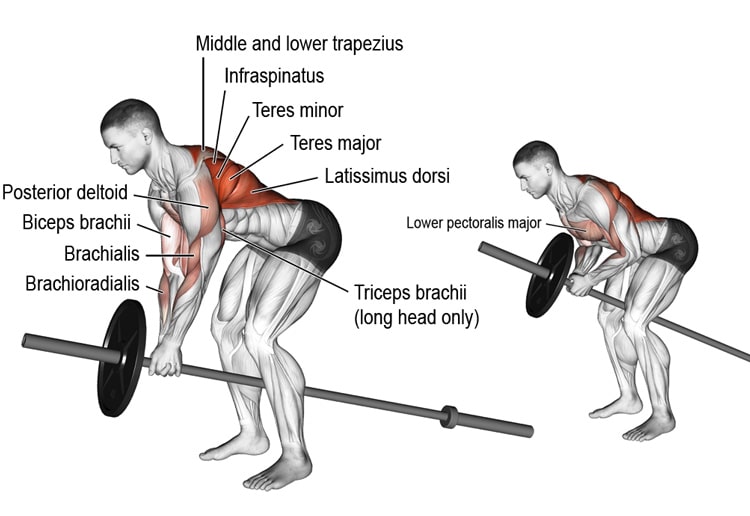
- Difficulty: Beginner
- Target muscles: Latissimus dorsi, Trapezius, rear Deltoid, Biceps
- Equipment needed: Barbell
- Sets: 2-4
- Reps: 8-12
- Rest: 60 seconds
To get an intense back exercise that allows you to build a strong and muscular back, add T-Bar Rows to your fitness routine. This move targets your lats, trapezius, rhomboids, and posterior deltoids.
Not only will this exercise improve your strength, but it will effectively help you get a wider back. However, proper form is crucial for targeting the right muscles and avoiding straining your lower back.
How to do a T-Bar Row:
- You can use a machine or barbell to perform this move. Start by loading the barbell with your desired weight, or adjust the machine to fit your body comfortably.
- Place your feet shoulder-width apart behind the machine and lay your chest on the pad.
- Grab the barbell with a neutral grip or hold the handles of the T-bar machine.
- Inhale and tighten your glutes and core.
- Pull the weight toward you. Squeeze your back and shoulder blades and hold the position for one second.
- Slowly lower the weight and exhale at the bottom of your movement.
8. Dumbbell Pullover
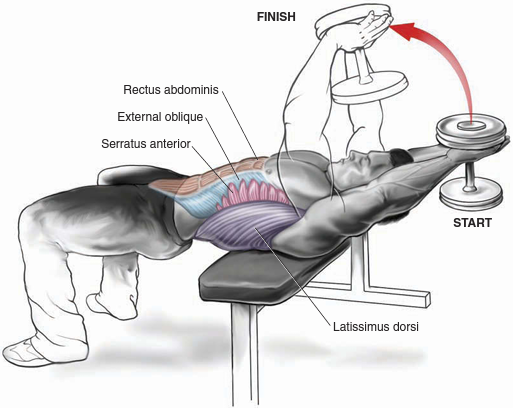
- Difficulty: Beginner
- Target muscles: Latissimus dorsi, obliques, pectorals, triceps
- Equipment needed: Bench and dumbbell
- Sets: 2-3
- Reps: 8-12
- Rest: 60 seconds
The dumbbell pullover is a classic bodybuilding move that is an excellent workout for your lats. This exercise works your back and chest simultaneously. When you perform it correctly, dumbbell pullovers are also one of the best tricep exercises that also work your lats.
To do a dumbbell pullover, you’ll need a dumbbell and a bench. Start with light weights to get used to the movement and test your range of motion.
How to do a dumbbell pullover:
- Place the dumbbell sitting up on a flat bench. Ensure it’s secure on the bench as you get into position.
- Lie perpendicularly on the bench with your shoulders on the bench.
- Place your feet solidly on the floor and set your hips slightly below the bench. Your head will also be off the bench.
- Use both hands to grab the upper head of the dumbbell. Hold it directly over your chest by extending your arms and keeping a slight bend on your shoulders.
- Keep both of your palms pressed against the underside of the top of the dumbbell. With your arms straight, slowly lower the weight over your head. Be sure to keep your core engaged and focus on your back and chest muscles.
- Keep lowering the weight until your hands are level with your head.
- Keeping your arms extended and muscles engaged, bring the dumbbell back to where you started.
Start by using no weights or light weights to master your technique before adding more weight. Once you’ve got the movement down, gradually increase the load. Perform 2-3 sets of 8-12 reps.
9. Seated Cable Row

- Difficulty: Beginner
- Target muscles: Latissimus dorsi, Trapezius, rear Deltoid
- Equipment needed: Cable machine
- Sets: 3-5
- Reps: 8-12
- Rest: At least 60 seconds
Research (6) shows that the seated cable row is as effective as a barbell row for training your latissimus dorsi muscles. However, it’s slightly different from using a cable because there’s constant tension in your muscles. If you’re working out in your home gym, purchasing a set of different handles can be great to mix things up and make sure you’re hitting the entire muscle group.
How to do a seated cable row:
- Sit on the bench with knees bent and grab the cable attachment. Ensure that it’s far enough away that you have to reach but not so far that you curl your lower back.
- Pull the attachment toward your lower abs while keeping your core and back engaged. Try not to use the momentum of your torso to pull the weight back.
- With the weight towards your abs, squeeze your shoulder blades together and keep your chest out.
- Pause at the top of the exercise for one second before returning the handle.
- Slowly extend your arms while keeping your back straight.
To focus on strength, perform two sets of 3-5 reps with a 1-2 minute rest between your sets. For hypertrophy (muscle growth,) do three sets of 8-12 reps with a minute or so of rest between each set.
Final Thoughts
Choosing the best lat exercises depends on your goals and the workout moves you enjoy doing. Once you try some of the workouts mentioned above, opt for the movements that you like to help you stay motivated.
If you want to grow your lats and have a bigger back overall, opt for wide-grip pull-ups and bent-over rows. These moves will allow you to strengthen and grow your upper body more efficiently than some exercises.
To pack on as much mass as possible, then be sure to add the T bar row to your workout routine. Your workout may look different if your goal is weight loss. Read How to Lose Weight Fast if you want to lose fat while gaining muscle.
Citations
- Master the Bent Over Row: Good Form and Variations, Healthline, 22 April 2022
- 5 Benefits of Lifting Heavy Weights, According to Experts, Very Well Fit, 13 June 2022
- Anatomy, Back, Latissimus Dorsi, National Library of Medicine, 5 April 2022
- Electromyographical Comparison of a Traditional, Suspension Device, and Towel Pull-Up, National Library of Medicine, 1 August 2017
- Erector spinae group, Radiopedia, 5 September 2022
- Comparative Electromyographical Investigation of the Biceps Brachii, Latissimus Dorsi, and Trapezius Muscles During Five Pull Exercises, Japanese Journal of Physical Fitness and Sports Medicine, 2005
- 10 Ways to Stretch and Strengthen Your Lats, Healthline, 3 June 2019
- Anatomy, Back, Latissimus Dorsi, National Library of Medicine, 5 April 2022
- Effects of grip width on muscle strength and activation in the lat pull-down, National Library of Medicine, 28 April 2014
- Single vs. Multi-Joint Resistance Exercises: Effects on Muscle Strength and Hypertrophy, Asian Journal of Sports Medicine, June 2015.
The Boss Hunting Fitness Reviewer — Jono Castano, Certificate IV in Fitness, Precision Nutrition Level 1
Jono Castano is a Sydney-based celebrity personal trainer and certified nutrition coach who specialises in fitness, training, workouts and diet plans. He is the co-founder of the popular Acero fitness brand and fitness app and has become well-known for his extensive work with noted figures like Rebel Wilson, Jessica Mauboy, Lincoln Lewis, Joel Creasy, and The Veronicas.
Jono has built a large social media following with over 800,000 subscribers on Instagram. He has also been profiled by publications such as Men’s Health and has become one of the most recognisable fitness instructors in Australia.
- Location: Sydney, Australia
- Credentials: Certificate IV in Fitness, Precision Nutrition Level 1
- Expertise: Fitness, Training, Personal Training, Workouts, Diet Plan
Editor’s Note: The fitness content on Boss Hunting is informative in nature, but it should not be taken as medical or professional fitness advice. When starting a new training regimen and/or diet, consulting with a trusted medical professional or trainer is always a good idea.
Did you enjoy this article on the best shoulder exercises? Check out a few of Boss Hunting’s other workout guides below:
- The 15 Best Exercises For The Perfect Leg Workout
- The 12 Best Shoulder Exercises For Improved Strength & Size
- The 15 Best Exercises For The Perfect Leg Workout
- The 16 Best Chest Exercises & Workouts For Men
- How To Bench Press [A 101 Guide For The Average Bloke]
- The 21 Best Rear Delt Exercises For Boulder Shoulders
- The 11 Best Tricep Exercises For Improved Strength & Size
- The 15 Best Bicep Exercises & Workouts For Men
- The 15 Best Ab Workouts & Exercises For Summer
- The 16 Best Oblique Exercises & Workouts For Men
- The 13 Best Trap Exercises & Workouts For Men
- The 10 Best Forearm Exercises & Workouts For Men
- 5 First Time Marathon Tips From Olympic Runner Brett Robinson
- The 25 Best Dumbbell Exercises & Workouts You Don’t Need A Gym For
- Why The 75 Hard Challenge Can Work For You
For more information to consider about diet, nutrition and, fitness equipment, check out below:
- Does Intermittent Fasting Actually Work? We Tested It Out
- How To Lose Weight Fast: 10 Simple Tips To Shed Fat More Efficiently
- The 7 Best Massage Guns You Can Buy In Australia
- The 13 Best Exercise Bikes To Stay Fit This Winter
- The 22 Best Mountain Bikes Money Can Buy Right Now
- The 16 Best Electric Bikes In Australia
- 8 Best Tennis Shoes for Men in Australia
For some celebrity inspiration, check out our celebrity workout guides right here:
- Henry Cavill’s Workout Routine Will Unleash Your Inner Superman
- The Workout That’ll Get You ‘Gladiator 2’ Ripped Like Paul Mescal
- The Chris Hemsworth Workout & Diet Plan Is Inhuman
- Jake Gyllenhaal’s Workout & Diet Plan To Get ‘Road House’ Ripped
- How Jeremy Allen White Got Calvin Klein Model-Jacked
- Joe Rogan’s Workout & Diet Plan Isn’t For The Faint-Hearted
- How Hugh Jackman Trained For His MCU Return In ‘Deadpool & Wolverine’
- Daniel Craig’s Military-Inspired Workout For ‘No Time To Die’
- How Michael Jordan’s Personal Trainer Helped Him Achieve GOAT Status
- The Bruce Lee Workout That Made His Rig Famous
- The Rock’s Intense Workout For ‘Hobbs & Shaw’ Will Bring You To Your Knees
For the best places to improve your health and fitness, check out our recommendations here:
